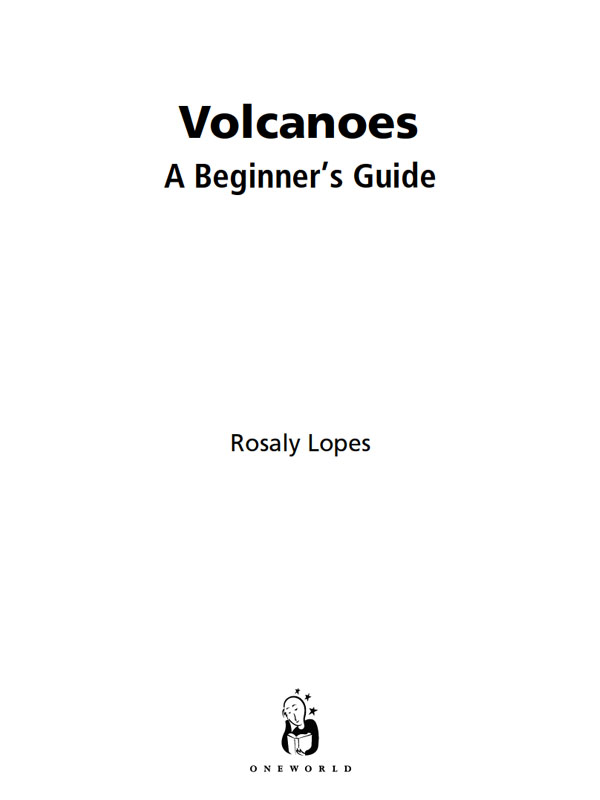Volcanoes
A Beginners Guide
ONEWORLD BEGINNERS GUIDES combine an original, inventive, and engaging approach with expert analysis on subjects ranging from art and history to religion and politics, and everything in between. Innovative and affordable, books in the series are perfect for anyone curious about the way the world works and the big ideas of our time.
africa
anarchism
aquinas
artificial intelligence
the bahai faith
the beat generation
biodiversity
bioterror & biowarfare
the brain
british politics
the buddha
cancer
censorship
christianity
civil liberties
classical music
climate change
cloning
cold war
conservation
crimes against humanity
criminal psychology
critical thinking
daoism
democracy
descartes
dyslexia
energy
engineering
the enlightenment
epistemology
evolution
evolutionary psychology
existentialism
fair trade
feminism
forensic science
french revolution
genetics
global terrorism
hinduism
history of science
humanism
islamic philosophy
journalism
judaism
lacan
life in the universe
literary theory
machiavelli
mafia & organized crime
magic
marx
medieval philosophy
middle east
NATO
nietzsche
the northern ireland conflict
oil
opera
the palestineisraeli conflict
paul
philosophy of mind
philosophy of religion
philosophy of science
postmodernism
psychology
quantum physics
the quran
racism
renaissance art
shakespeare
the small arms trade
sufism
volcanoes


A Oneworld Book
Published by Oneworld Publications 2010
This ebook edition published by Oneworld Publications 2012
Copyright Rosaly Lopes 2010
The moral right of Rosaly Lopes to be identified as the Author of this work has been asserted by her in accordance with the Copyright, Designs and Patents Act 1988
All rights reserved
Copyright under Berne Convention
A CIP record for this title is available from the British Library
ISBN 978-1-85168-725-1
ebook ISBN 978-1-78074-181-9
Typeset by Glyph International
Cover design by vaguelymemorable.com
Oneworld Publications
10 Bloomsbury Street, London, WC1B 3SR, England
Stay up to date with the latest books, special offers, and exclusive content from Oneworld with our monthly newsletter
Sign up on our website
www.oneworld-publications.com
This book is dedicated to the explorer and adventurer Ralph B White (19412008)
Acknowledgments
Many colleagues provided valuable input and illustrations for this book. I am particularly grateful to Scott Rowland who has generously allowed me to use many of his beautiful photographs, to Charlie Bluehawk who drafted some of the diagrams and to Chuck Wood who reviewed the manuscript draft and made excellent suggestions. My editors at Oneworld have guided this book to completion; my special thanks to Fiona Slater, Marsha Filion and Victoria Roddam.
Illustrations
Colour plates
What are volcanoes?
What is your idea of a volcano? The image that probably comes to mind is a violent, angry mountain, spewing out black clouds of ash and rivers of red-hot lava, burning villages and causing devastation and tragedy. We think of Vesuvius in Ancient Roman times and its destruction of the libidinous Pompeii; we think of the eruption of Krakatoa in the nineteenth century and its catastrophic tsunami that took countless lives.
Every now and then, the media focuses on a volcano that is at the very least worrying local people and sometimes playing downright havoc with their lives. In 2010, the Eyjafjallajkull volcano in Iceland demonstrated just how disruptive volcanic eruptions can be. Although its eruption was small compared to eruptions such as that of Pinatubo in 1991, its ash cloud, rising up to nine kilometers high, blew over Europe, stopping air traffic for several days. Thousands of travellers were stranded and the economic impact was felt world-wide.
All these images are true some of the time but, in reality, volcanoes come with different shapes, sizes and temperaments. It is fascinating to study what causes these differences and understand that, while some generalisations are possible, each volcano has its distinct quirks, just like people. We could also compare volcanoes to cats: with few exceptions, they spend most of their lives asleep.
We will start our fascinating journey of understanding volcanoes on Earth, travelling from its beginnings to the evolution of its many cultures, with their diverse explanations of what volcanoes are and why they erupt. We will then travel on to the other planets of our solar system: volcanoes are fundamental to the formation of planets and many types exist, from the rampant, hot volcanic activity of Jupiters moon Io to the cold, exotic cryovolcanism (eruptions consisting mostly of liquid water from the interior of icy moons) in the outer solar system.
What, exactly, is a volcano?
A volcano is an opening on the surface of a planet from which magma and/or magmatic gas emerges. Magma is molten rock, containing dissolved gases and crystals; it originates in the mantle, which typically lies eighty to one hundred kilometers below the planetary surface. When a volcano erupts, magma emerges in one or more forms: continuous lava flows, fragments varying in size from boulders to ash or rapidly flowing currents of hot gas and rock fragments. The erupting lava and gases build up around the opening (or vent) to form the volcano.
The landform created could be a field of lava, a cone or, eventually, a mountain. Sometimes lava pours out onto the surface without explosions and no built-up landform is discernible. You can walk for miles over the lava fields of the Krafla volcano in Iceland without climbing a mountain or even a sizeable hill: Kraflas lavas pour out of great fissures and the volcano is all around you. On other volcanoes, the exploded fragments of lava that land close to the vent build relatively small but steep-sided cones, such as the cones of Stromboli in the Aeolian Islands and Sunset Crater in Arizona, USA. The combination of lava flows and explosive eruptions over long periods builds the tallest volcanoes, such as Mount Fuji in Japan, a volcano that, for many, is the classic, with its convex-upward shape and serene, snow-capped summit.













